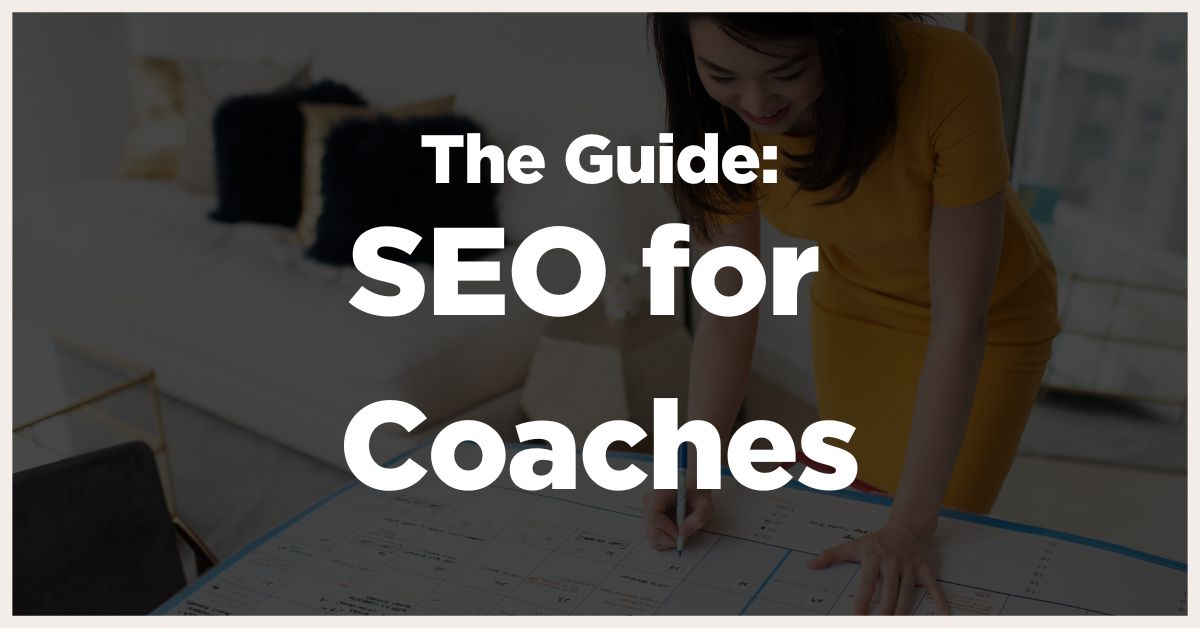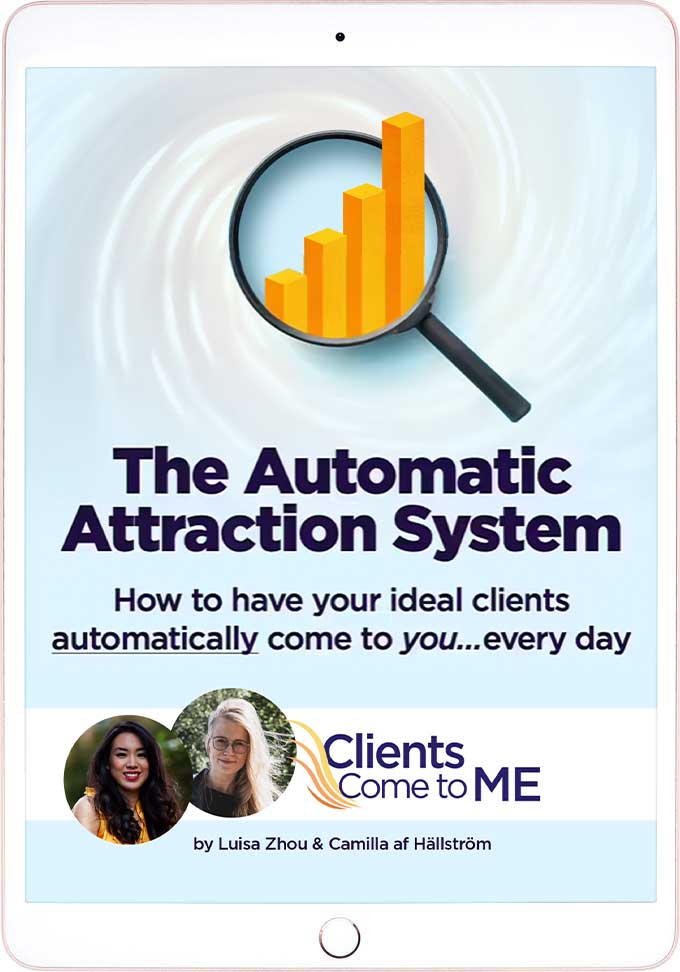Want to use SEO to scale your coaching business?
You’re in the right place! In this article, you’ll learn all about SEO for coaches, so that you can build a truly scalable and profitable business.
Want to learn more? Let’s get started!
You’ll learn…
- What is SEO?
- How do you find the right keywords?
- How do you create SEO content?
- What are the best backlink building strategies?
- How do you convert SEO traffic to sales?
What is SEO for coaches?
Search engine optimization, or SEO, is all about optimizing your coaching website and content for search engines. You see, with the right strategies, you can get outsize results.
SEO means that you improve your website to rank better on search engines like Google. When people find your web page, they click through, and some of them go on to buy from you.
And SEO is one of the most effective ways to get new traffic and clients.
53% of all trackable website traffic comes from search engines. That far exceeds any other traffic source. 66% of people perform some type of online research before making an online purchase. And 14.6% of leads from search engines buy from you, versus 1.7% of leads coming from paid advertising or cold calling.
At the same time, SEO is often an overlooked traffic source, and chances are that your competitors aren’t using it to its full potential.
But first, what exactly can SEO do for your business? Let’s find out.
What are the benefits of SEO for coaches?
Search engine optimization can make ALL the difference for your business.
Not only is it more profitable than most other marketing strategies… It also requires less work in the long term.
That’s why I started using SEO a few years ago.
No one else in the industry was doing it. As a result, there wasn’t even that much information available. And definitely no “proof” it was the right choice.
But the results have blown me away. Thanks to the system I use, I haven’t had to rely on paid ads, social media, pitching clients, or “hustling.”
Within the first six months, I started making more than I was investing in SEO.
And after two years, I was making multiple six-figures–and that number is rapidly growing.
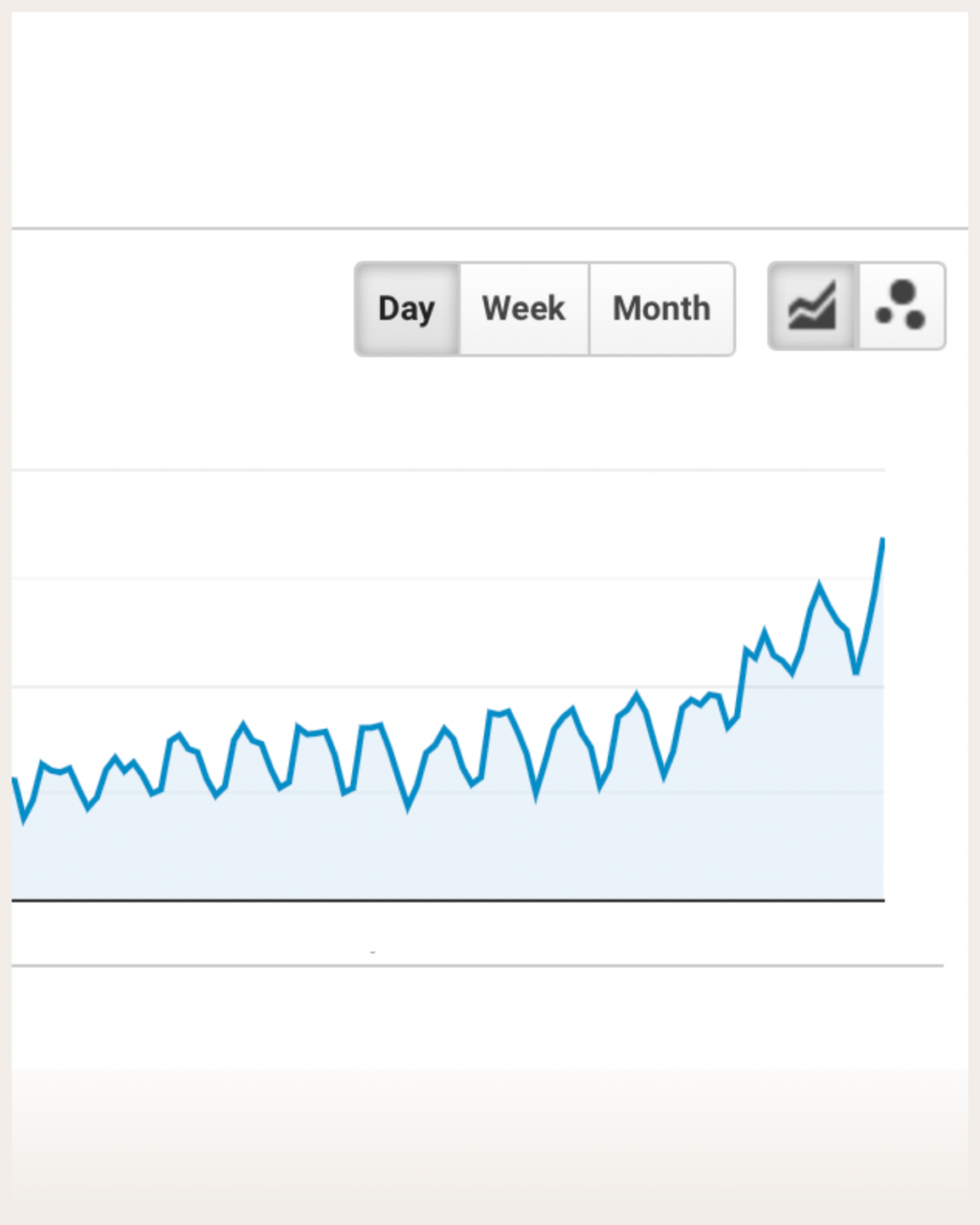
(To achieve this, I used the steps below. However, they weren’t the only steps I used and while they are definitely important elements of a successful SEO strategy, they are just that–parts of a system. More on that system below!)
While social media marketing can be unpredictable and ad costs increase whenever a social platform becomes more popular, SEO results are far more stable. Once your website ranks on search engines like Google, you don’t pay for those rankings.
So for example…
Here’s one of my blog posts that ranks for a targeted search term (in this case “selling coaching services”):
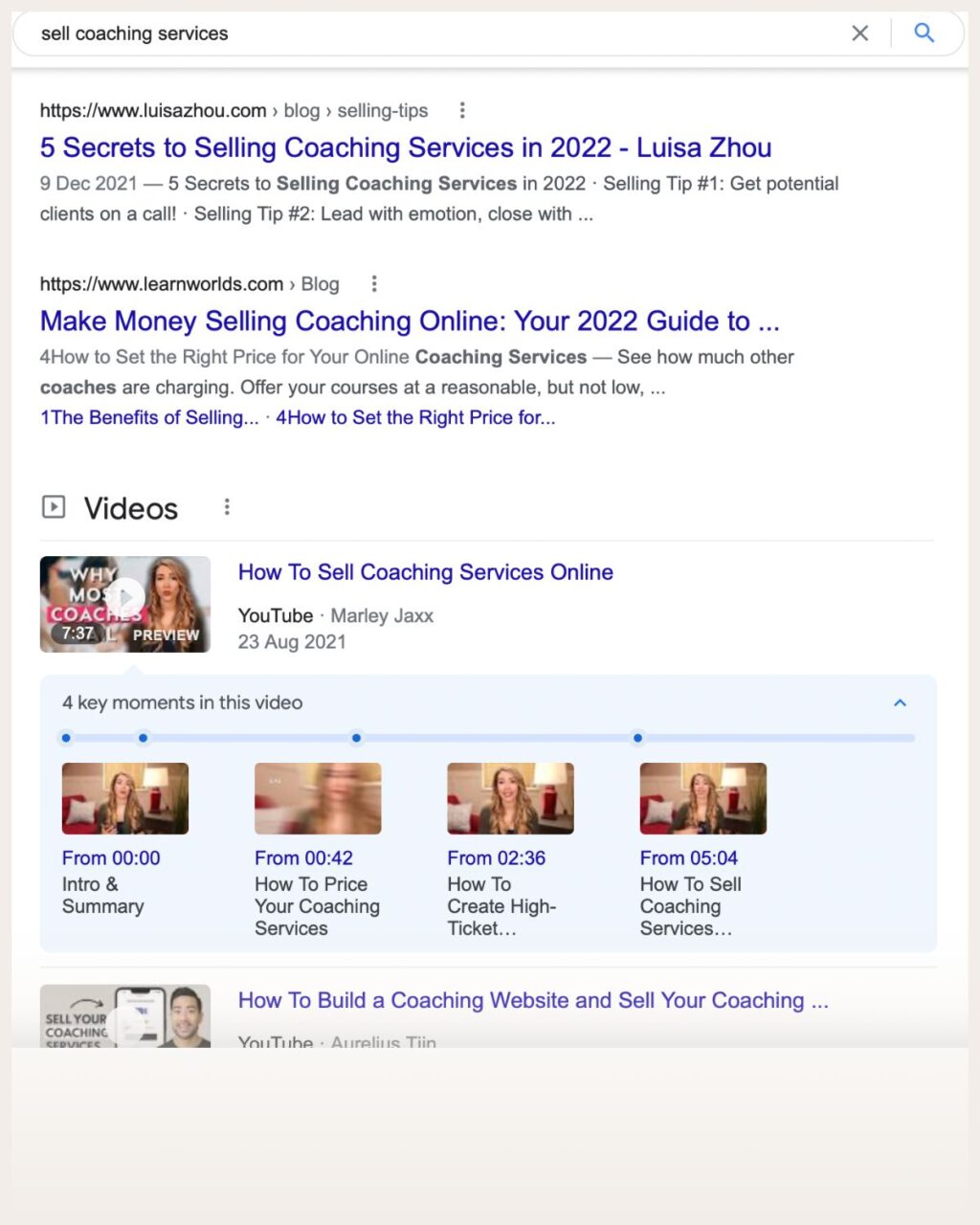
It attracts my target audience to my website–every day. Without me having to actively do anything to find them or get them to come to my blog.
Chances are, you found this article you’re reading right now thanks to a search engine.
In other words, SEO traffic can be MUCH more profitable than advertising.
And it’s more scalable than other marketing strategies, including guest posting and podcasting.
What’s more, social media requires you to come up with new content and post every day to keep up the momentum. In contrast, every piece of content you create that ranks on Google lives on and continues to generate leads and sales.
The 4-Step Automatic Attraction System
for attracting more clients daily... without paid ads, social media, or "hustle"!
Also, your competitors are likely not using SEO to its full extent. That’s because people tend to think that SEO is “too technical” or that it doesn’t work for coaches, freelancers, consultants, and other service providers–both of which are complete myths. You just need to know HOW to use it, and that’s what you’ll learn in this post.
The best part is that with your search engine strategy, you can create an automated sales system. Want to learn how? Get my guide “Automatic Attraction System” where I show you the steps.
So let’s dive right in. How do you attract coaching clients from SEO?
How do you get coaching clients with SEO?
The way you get clients from SEO is by optimizing your content so that it ranks in search engines. When people google (or search on other search engines), they find your content and click through.
By using a lead magnet (a free gift, like a PDF or a video that people get when they sign up for your email list), you give your new site visitors a reason to opt in and, that way, you grow your email list.
Ultimately, a portion of your new email subscribers buys from you.
And that’s how SEO generates new clients for you.
However, creating the right content is just one part of the equation. You also need backlinks (links from other websites pointing to your website domain).
We’ll look more at how to get backlinks, but first, let’s find out how to get the RIGHT traffic to your website, AKA your ideal clients, by using strategic keywords.
What are the best SEO keywords for coaching?
What are keywords?
Google uses algorithms to rank your content. And to gather data, it crawls your website with what’s called spiders. Now, the algorithms are very smart, but they aren’t smart enough to understand your content without any type of context.
That’s where keywords come in. These are the words you use to optimize your content so that Google’s spiders understand what your page is all about.
Every page focuses on just ONE keyword. But if you optimize your site in the right way, you will also rank for other, related keywords.
That said, how do you know what keywords to use?
To find keywords you can use for your SEO, there are a few steps you can take. These are:
Google Keyword Planner
First up is Google Keyword Planner. This is Google’s keyword tool for researching keywords for Google ads.
But you can also use it to find keywords for your organic (AKA non-paid) SEO.
Go to Google Keyword Planner and type in a word related to your coaching services (such as “career coaching” or “health coaching”). Scroll through the results to get keyword ideas.
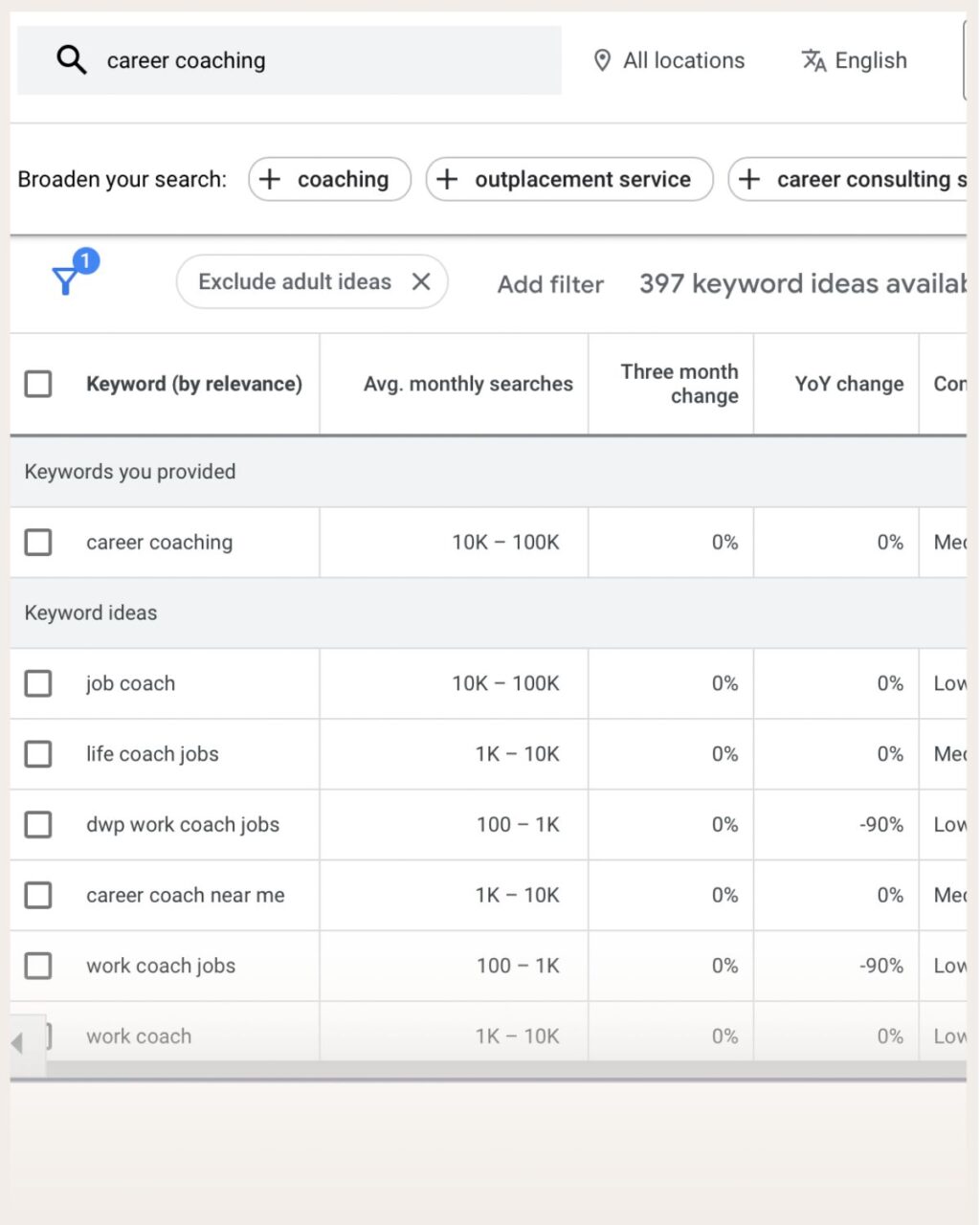
You can also select “Start with website” and see what keywords your competitors rank for.
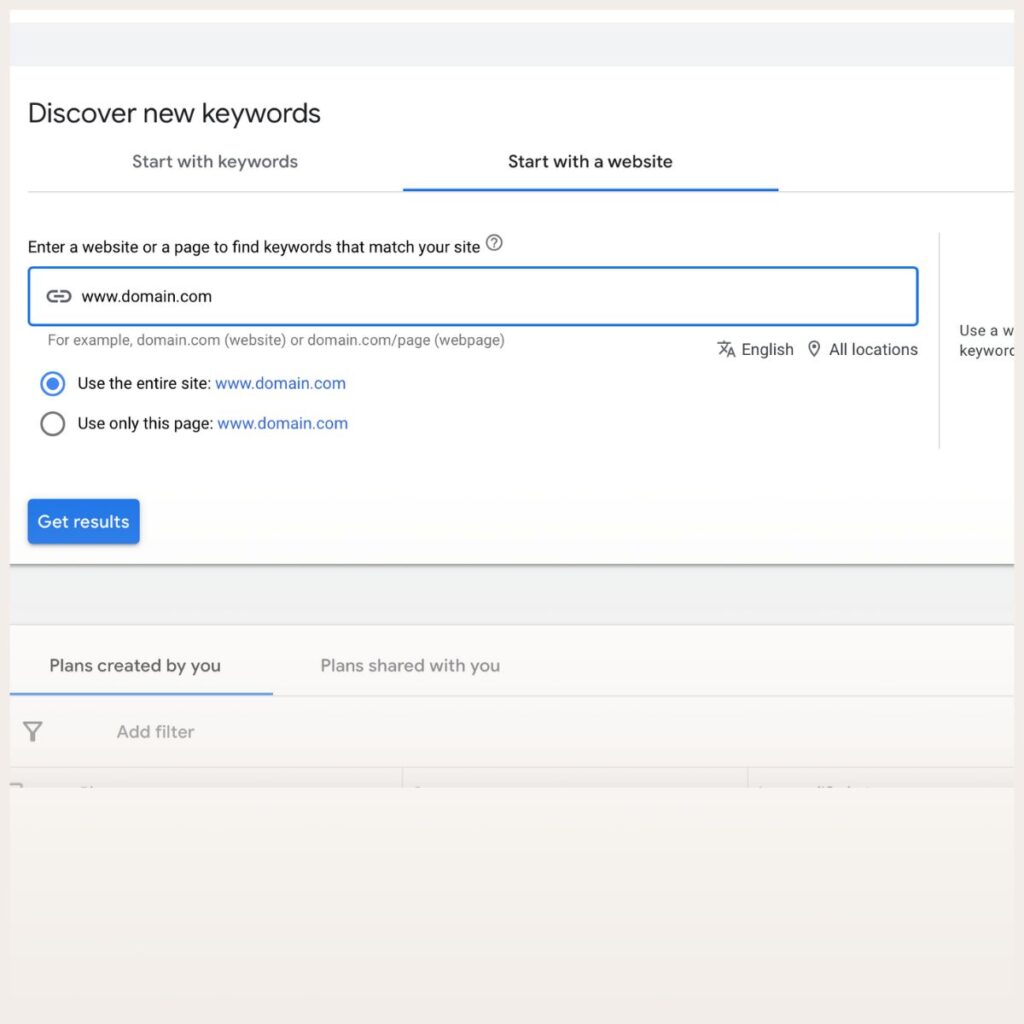
When you choose keywords, keep an eye on the metrics you get in Google Keywords Planner.
First of all, “average monthly searches” shows the traffic a keyword gets. However, while bigger search volumes are good, don’t stare yourself blind on this metric.
Instead, look at the page bids. These tell you how much people are willing to pay for ads that target this keyword.
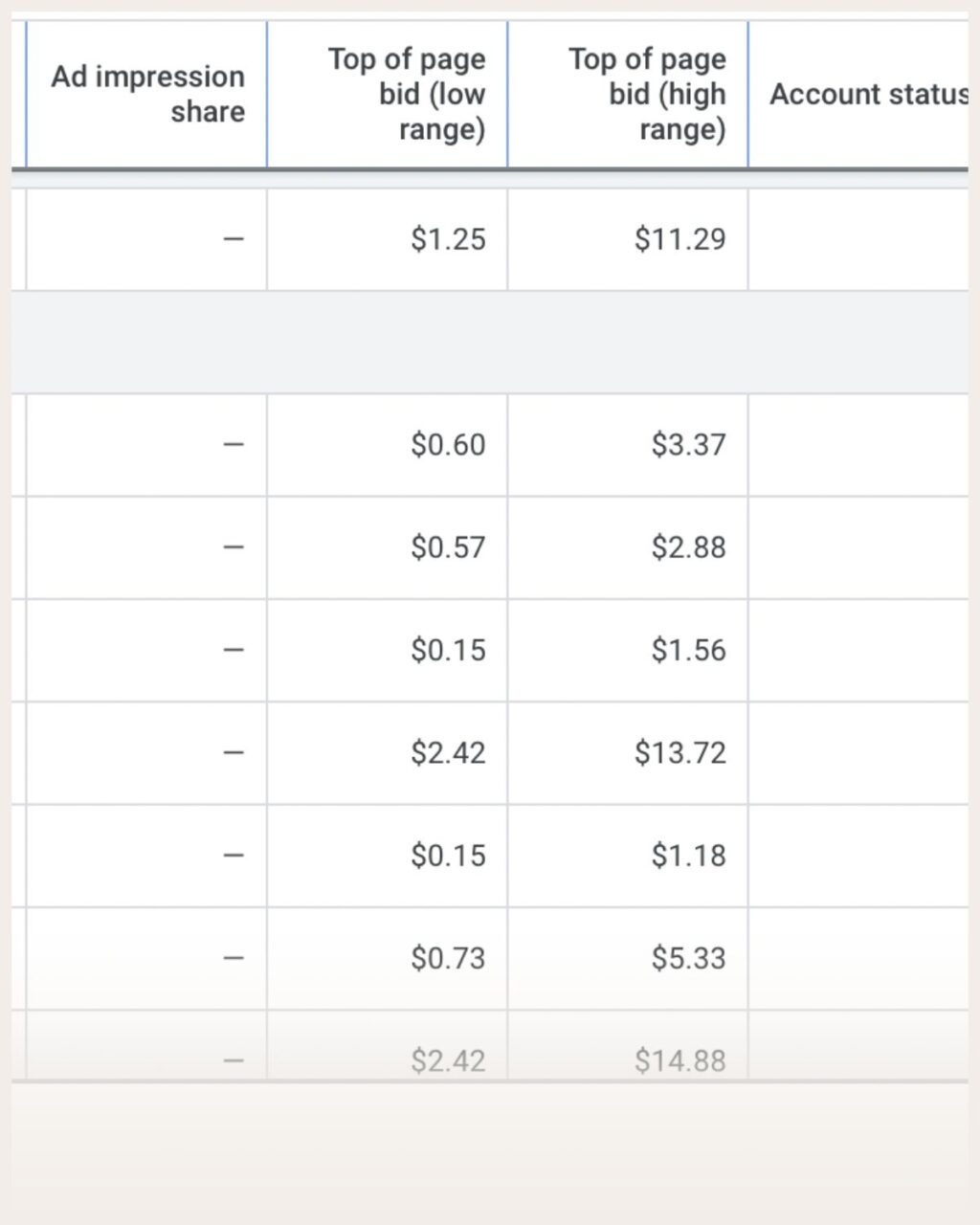
And if the bid is on the higher end (at least $1), it’s great news for you because then you know this is a potentially valuable keyword. (Caveat: While this serves as a rule of thumb, there are obviously keywords that have a low bid and are still really valuable.)
Plus, look at how difficult it is to rank for a keyword.
If the entire first page of search results is made up of really big sites (think: New York Times, Wikipedia, and Times), then you might just skip that keyword.
It’s somewhat hard to rank your website, especially in the beginning, before you have built up your SEO. And that’s why it’s far better to go for a lesser competitive keyword with a high page bid than a keyword with a lot of traffic because you probably won’t rank for that keyword very easily.
A paid SEO tool
With paid SEO tools like Ahrefs and SEMrush, you can get a lot of keyword ideas AND make your keyword search faster.
For example, Ahrefs’ tool “Keyword Explorer” gives a lot of data on each keyword.
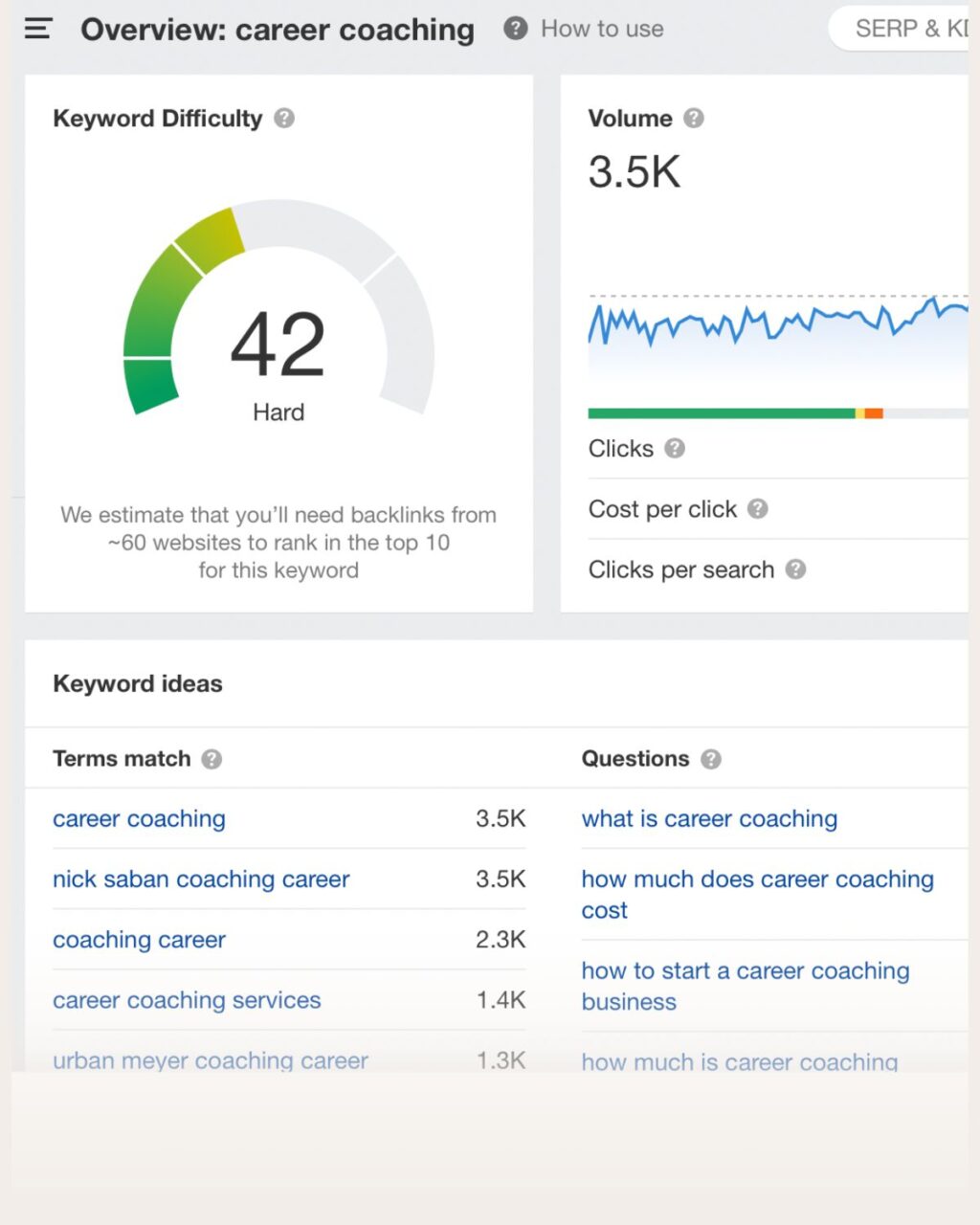
What’s more, paid keyword tools show you how competitive it is to rank for keywords.
Google searches
Finally, you can use Google searches to find keyword opportunities.
In that case, you simply search for keyword ideas and get more ideas thanks to the suggested searches in Google’s results.
Look at the “People also ask” section, as well as the related searches at the end of the search results.
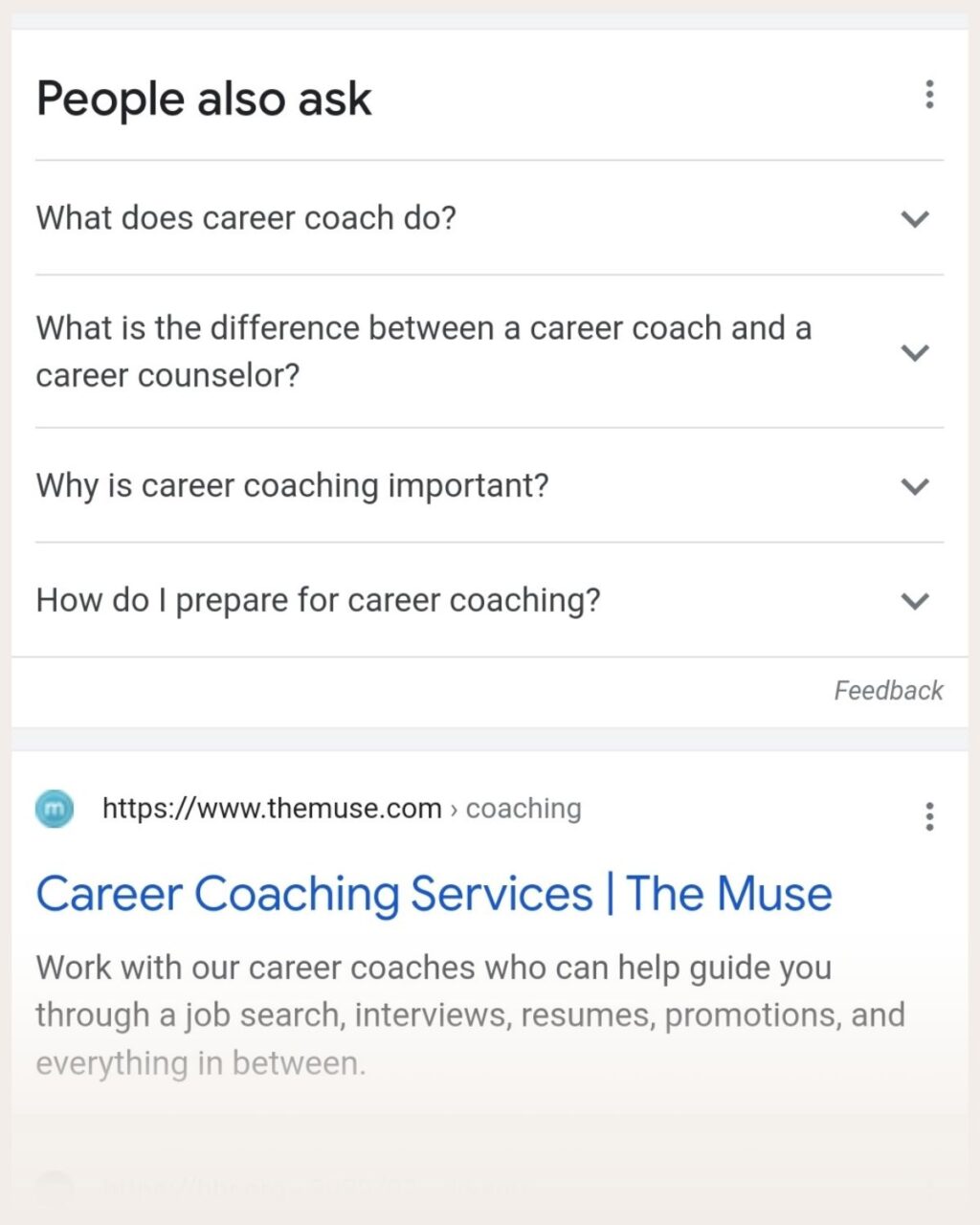
But what are some specific keywords in different coaching niches? Let’s take a look.
The best keywords for life coaching
I actually don’t recommend you to market yourself as a “life coach.” Niching down is a far better option to attract high-end clients who are willing to pay a premium price for your coaching.
As you can see here, many of the keyword suggestions for the keyword “life coaching” are coaching niches–simply because people are more likely to search for coaching that helps them with a specific thing.
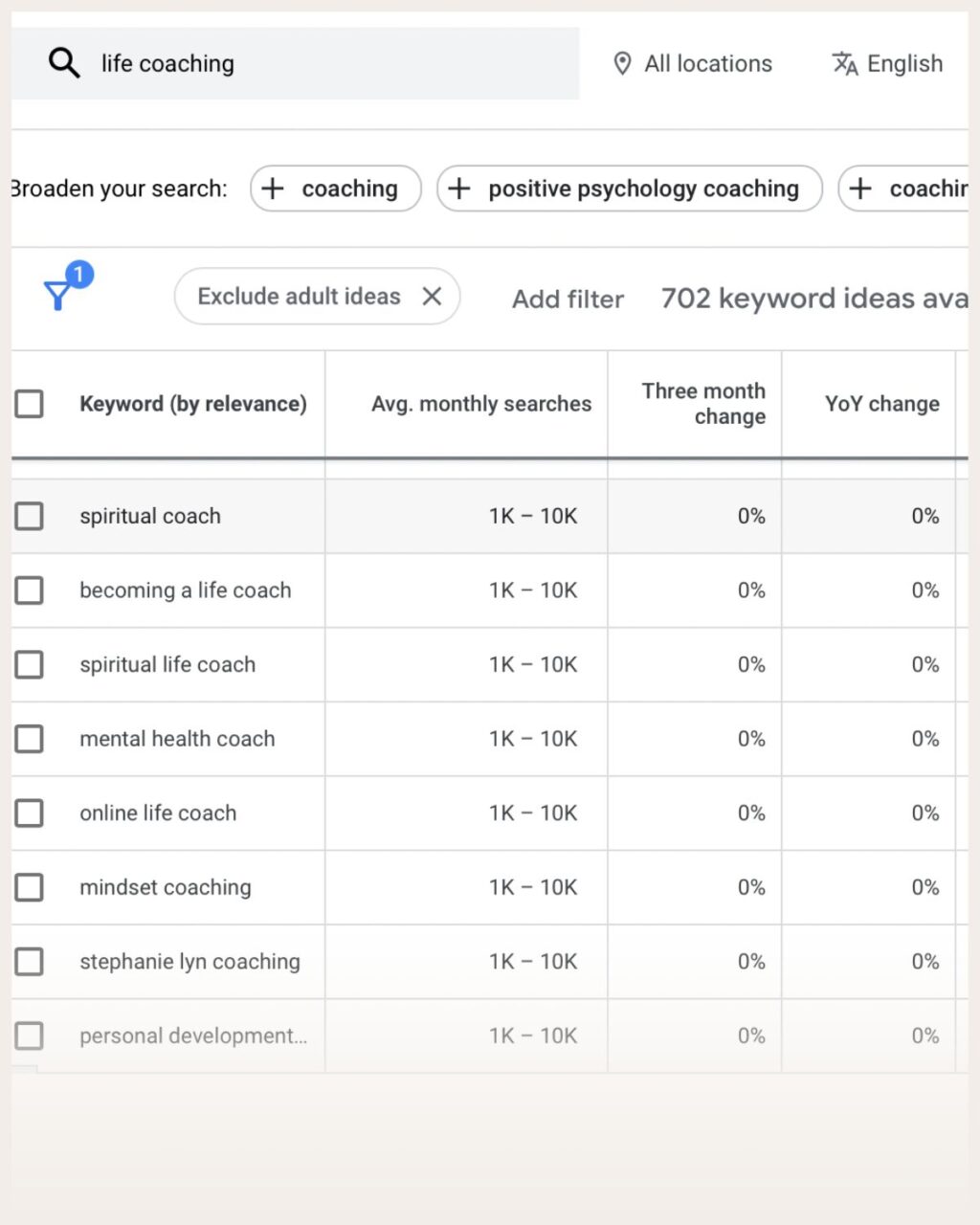
The best keywords for health coaching
Search for keywords related to health coaching to find relevant health coaching keywords. Make sure you use relevant keywords, so if you’re a nutrition coach, use those types of keywords rather than the broader “health coaching” keywords.
The best keywords for business coaching
Business coaching also requires you to niche down to attract the right people. There are plenty of keywords in this niche including “marketing coach”, “CEO coaching”, “entrepreneur coach”, “startup coach”, or even “Amazon FBA coach”.
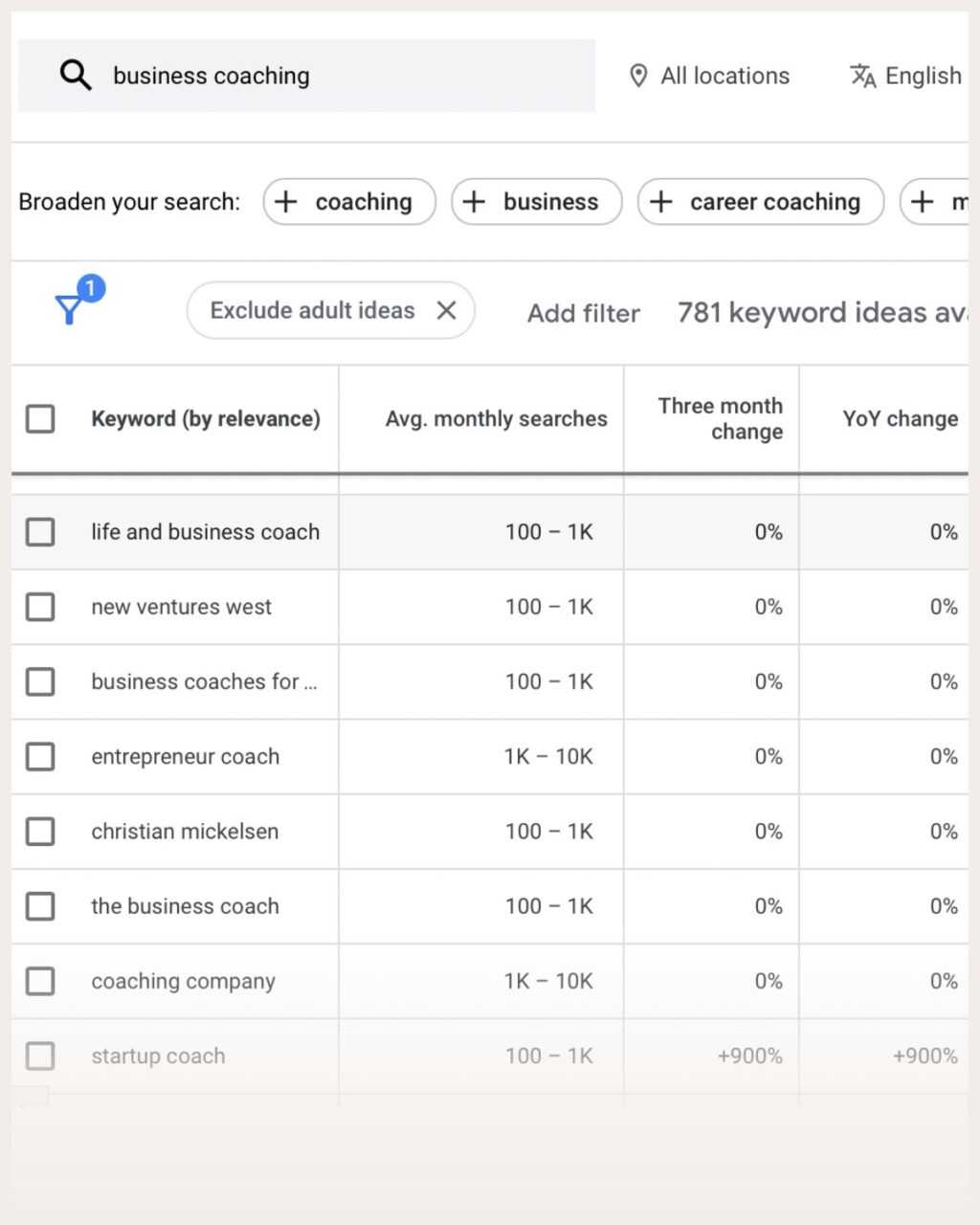
The best keywords for career coaching
And the last keyword group we’ll talk about here is career coaching keywords. Here, you can find niche keywords like “career transition coach” or “tech career coach” to name a few.

But how do you use the keywords you’ve just found?
Unless you’re creating a website page (like a service page), you’ll use them for your blog posts.
And here’s how to use your keywords to get your blog posts to rank.
How do you create content that ranks?
Content is one of the most important parts of your SEO strategy.
That’s because you use your content to scale your SEO. It’s also the first thing people see when they come to your website, so your content is all about building trust fast.
On the flip side, if your content is only so-so, people won’t stick around or opt into your email list.
Create content that stands out
I have a goal with every blog post I create:
It needs to be better than other content out there.
With “better”, I mean more comprehensive, engaging, and actionable.
That’s how I was able to grow my SEO traffic into a multiple six-figure income stream in two years.
The best part is that many of the blogs I’ve published a few years ago continue to bring in traffic and clients.
For instance, this blog post helps people become health coaches. It’s pretty detailed; you learn everything from picking the right niche to growing your coaching business.
And to this day, it continues to help people start their health coaching businesses:
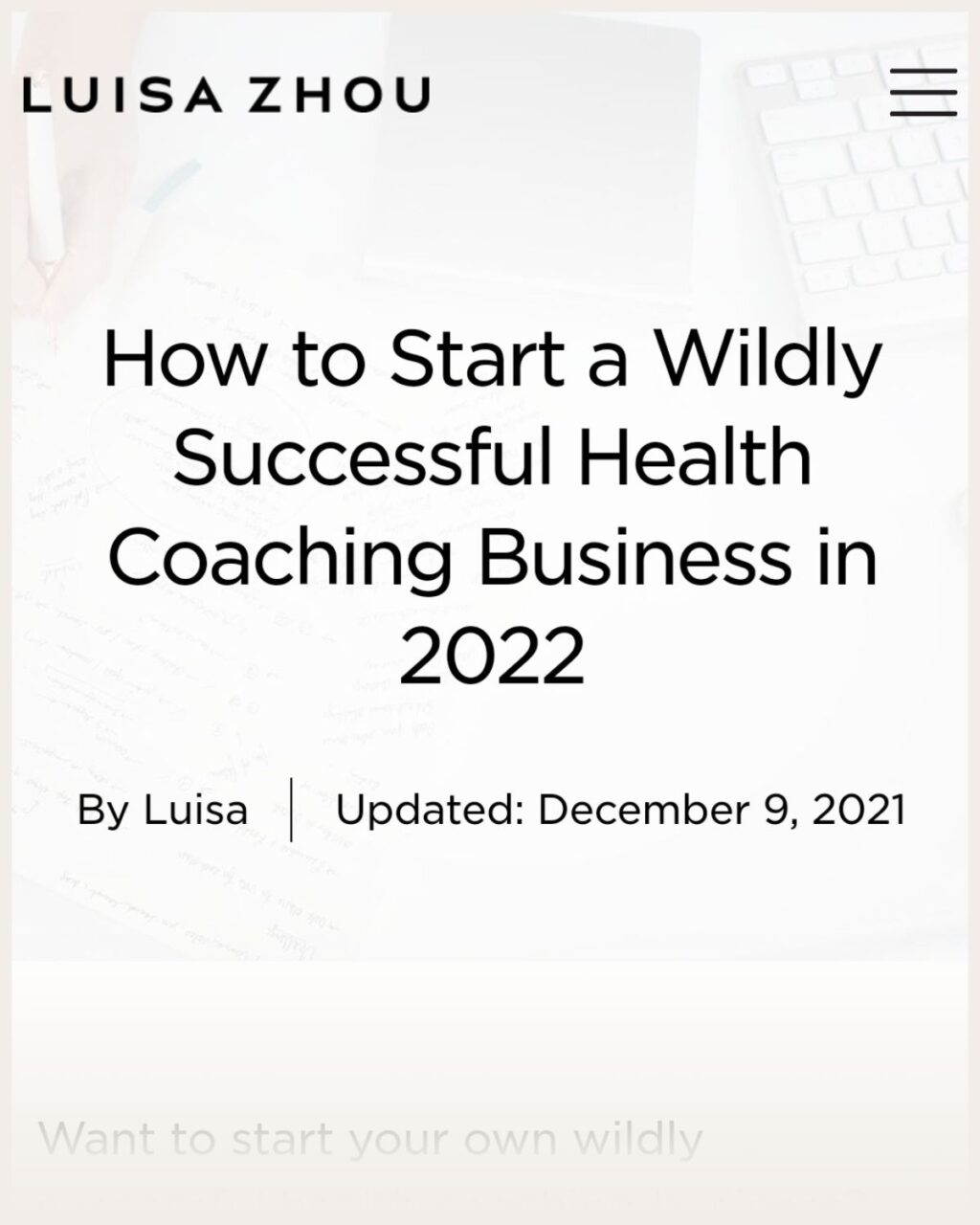
There are no rules on how long your content should be.
But valuable content tends to be a bit longer, just because you’re able to include more information in your post. That said, you definitely shouldn’t include any “fluff” but focus on making pretty much every sentence count.
Optimize your blog posts
Also, your content needs to be optimized.
And that’s something you’ll accomplish with SEO titles, meta descriptions, and alt tags.
You can use the plugin Yoast (for WordPress websites) to optimize your blog posts.
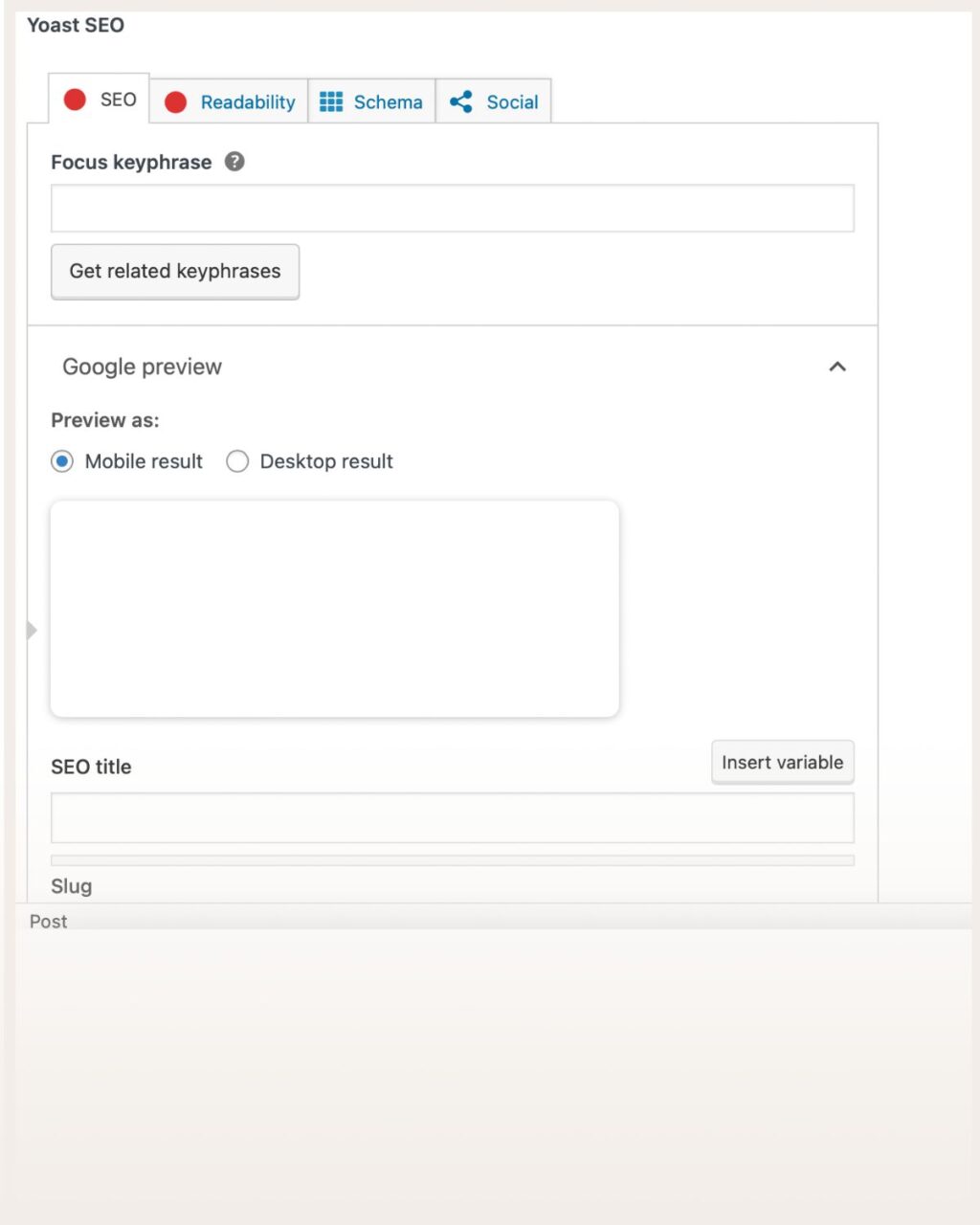
In that case, add your target keyword (the keyword you’re optimizing your blog post for) to Yoast, as well as your other SEO elements.
Yoast will then give you a score (green = good, yellow = ok, and red = bad) that helps you determine if you need to further optimize your blog post. You also get helpful tips to improve your blogs.
If you use a website builder like Squarespace, those builders tend to have an in-built option to add your SEO elements.
Write clickable SEO titles
The first thing to add to Yoast is an SEO title that stands out in Google search.
After all, your SEO title is the first thing someone sees in search results:
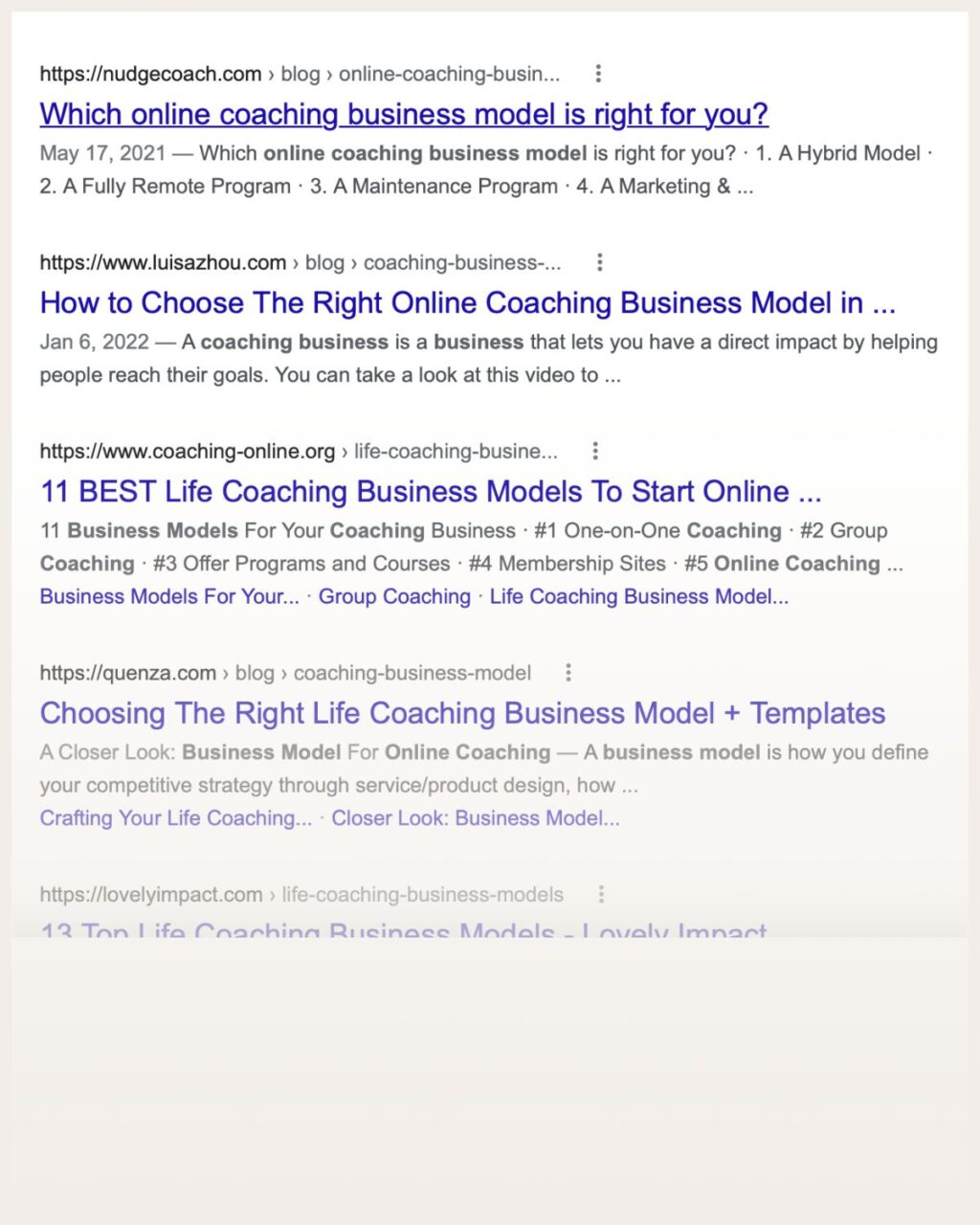
And so you need to be able to out-compete all the other SEO titles on Google.
Use your target keyword in the title and make your title as to the point as possible.
However, there are a few things you can use to spice up your title:
- Use “how to” titles or number titles (“21 Ways to…”)
- Use superlatives (“best”, “top”, “great”)
- Make your title approximately 50-70 characters long so that it fits in Google’s search results
- Try to include the end result or benefit of your article (for example, “start a successful side business” or “learn how to make a 10-minute no-bake cake”)
For instance:
“21 Best Public Speaking Tips to Become a Confident Speaker”
Or:
“How to Become a Successful Speaker (Even if You Don’t Enjoy Speaking)”
Create compelling meta descriptions
Your meta description is that short description that pops up under your SEO title in search results.
Use meta descriptions that are 50-160 characters long so that they fit in the search results.
You don’t need to overthink this. Simply include a description that helps people decide if your post is the right one for them. Make sure you include your keyword in your meta description, though!
For example:
“What are the best public speaking tips? Here are 21 tips to help you become a more confident speaker people love to listen to.”
Write alt tags
And finally, your images need alt tags. These are very short descriptions of your images.
For example, let’s say you use an image of a flower. You’d use an alt tag like “vase with flowers” to describe your image.
If you can, use your keyword in at least one alt tag on your page.
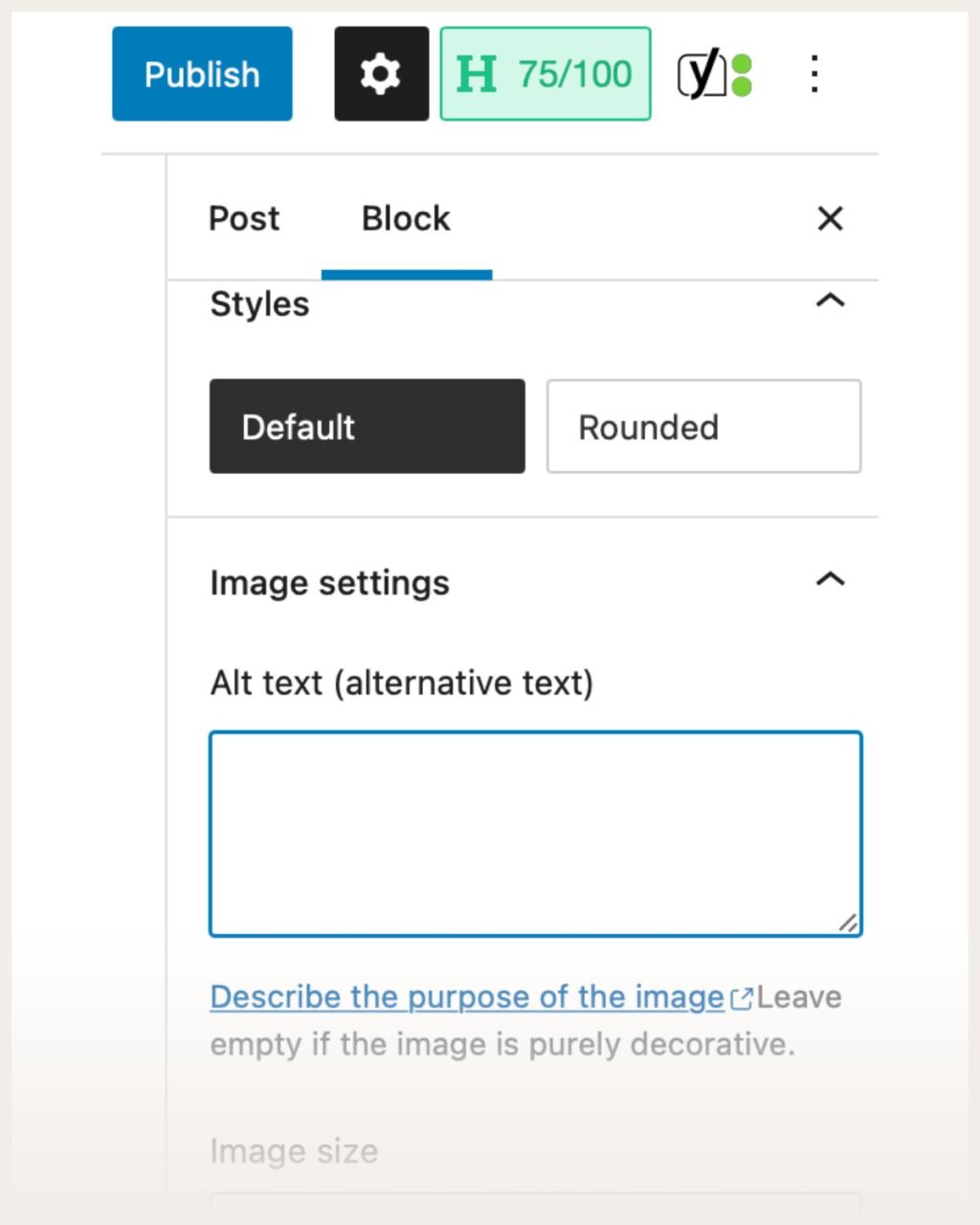
And that’s it–that’s how you optimize your blog posts.
Now that you’ve figured out how to create content that ranks, how do you improve the rest of your SEO?
That’s what we’ll look at next.
How do you use backlinks to grow your traffic?
One of the main elements of your SEO strategy is to use backlinks or external links pointing to your website.
Now, not all backlinks are equally valuable. The best backlinks are those that are relevant and high-quality links.
So if you’re a health coach and Women’s Health links to your website, you’ve just earned a really valuable backlink. That said, Forbes linking to your site is also a big deal, but so is a backlink from a smaller health blog.
But how do you get backlinks?
You can get as creative as you want (as long as you don’t pay for links as that’s a big no-no), but here are a few ideas:
HARO
Help a Reporter or HARO is a free newsletter with queries from journalists and bloggers looking for article sources. The newsletters are sent out three times a day.
Whenever there’s a relevant query, you’ll send a pitch to them answering that query. If they choose your pitch and include it in the article, you get a backlink.
And HARO can be a fantastic way to earn high-quality backlinks. I’ve used this strategy to earn high-quality backlinks such as this one from Bloomberg:
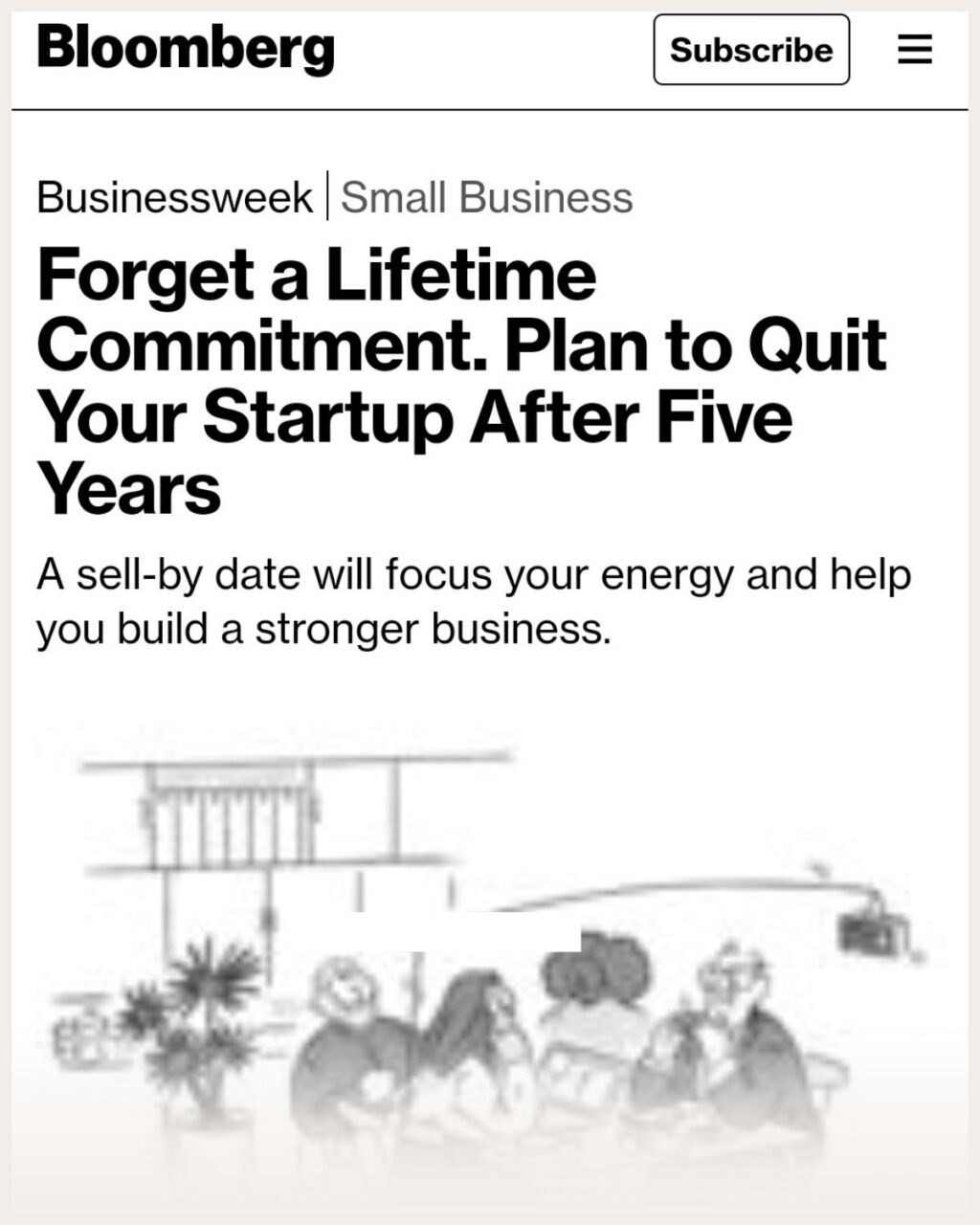
Guest posting
Guest posts are a great way to build links, as long as you focus on high-quality blogs in your industry. In other words, don’t just pitch blog posts for the sake of it but focus on bigger websites in your industry or smaller blogs that publish quality content.
For instance, my articles have been featured on websites like Business Insider, which has earned me several great backlinks.
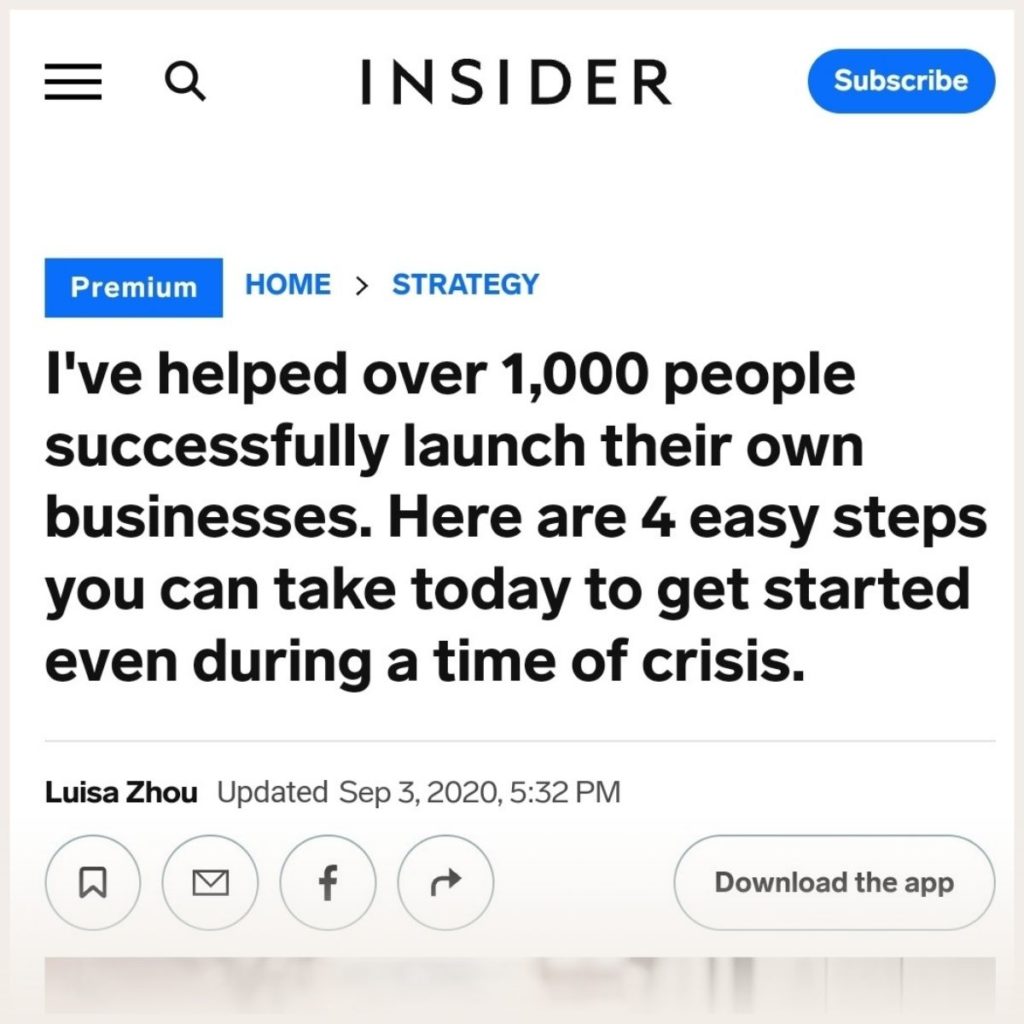
Podcast interviews
And finally, you can pitch podcasts to get backlinks. Podcast hosts typically include your website in the show notes and that’s how you get a backlink from them.
For example, here’s my own podcast interview on the “So Money” podcast:
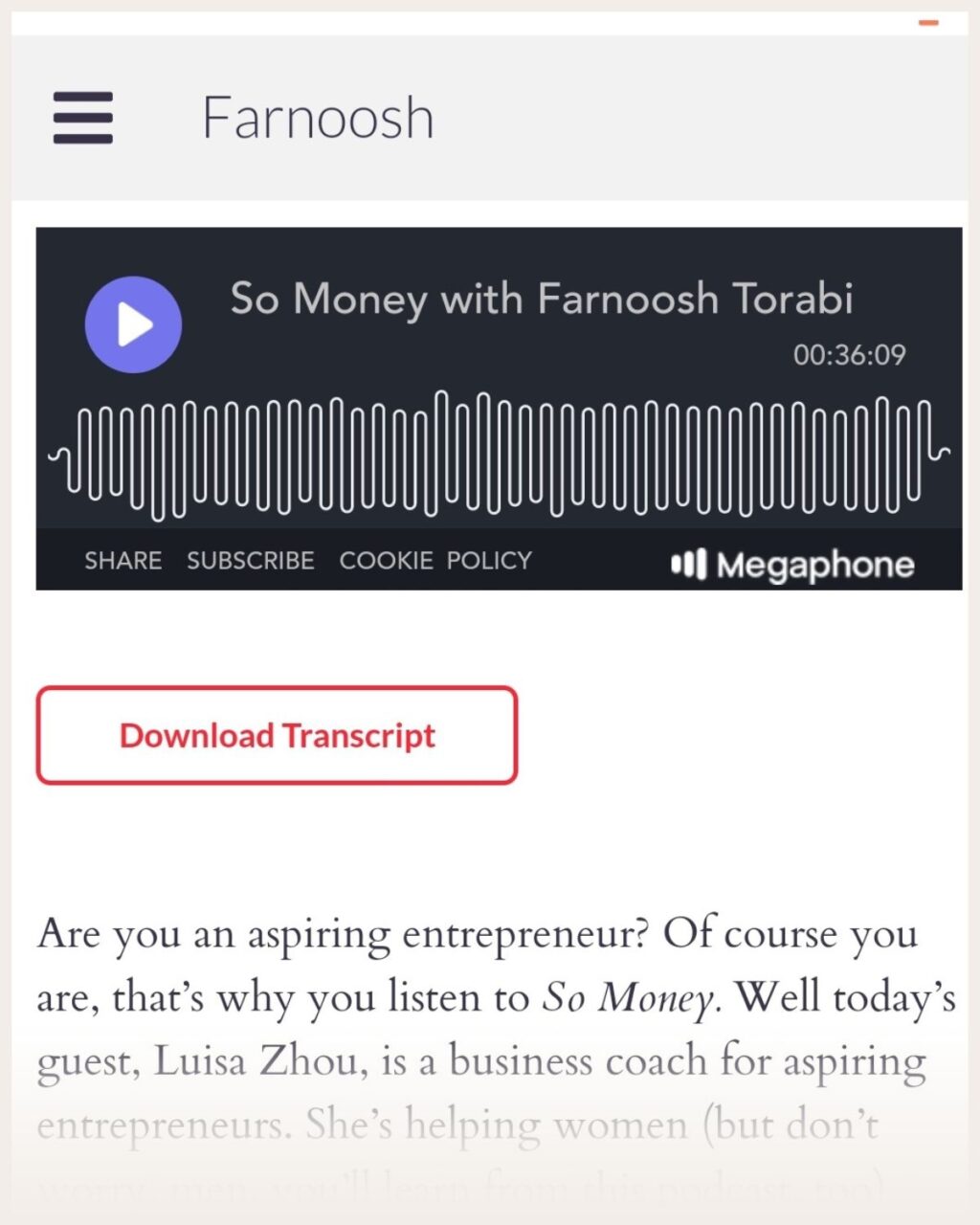
Just note that backlink building tends to take some time and is by far the slowest part of building your SEO. But it’s so worth it because with the right, consistent backlinks, your traffic takes off.
But once you have that traffic, how do you convert it into paying customers? Let’s take a look.
How do you convert your website visitors?
Finally, how do you get your website visitors to buy from you?
There are two parts to this:
Converting website visitors into email subscribers and converting email subscribers into buyers.
Attract email subscribers and buyers
First, you need to convert website visitors into subscribers.
People sometimes ask me, “What about sending my website visitors to my social channels?”
But as email marketing statistics show time and time again, email is a more effective tool for converting people than social media. In fact, email generates $42 for every $1 spent. And while 60% of consumers have bought something thanks to a marketing email, only 12.5% say they would consider buying something directly on social media.
That’s why I strongly recommend that you build an email list instead.
Second, you need to convert subscribers into buyers.
Your sales system can include different parts, depending on your offers. A typical sales funnel is to send out an email sequence where you introduce people to your offer. You might also include a webinar and at the end, send your subscribers to a sales page where they can buy your services or products.
Or, you could use an email sequence to get people to hop on a coaching discovery call with you.
If you don’t have a sales system in place for converting email subscribers into buyers, you need to first set up that system. That’s outside the scope of this blog post, but take a look at the courses I offer – Sold Out Sales Emails, Sell More with Webinars, and Sold Out Sales Pages to build your own system.
Grow your email list
So with that said, let’s take a look at how you convert visitors into email subscribers.
The first thing you need is a lead magnet.
A lead magnet is typically a PDF that outlines a small step people take on their journey to achieve a goal. It could be an overview of your strategy, a list of foods you recommend, or an exercise that will help them get a specific result.
Here’s one of my own lead magnets, a PDF that shows my website visitors how to build a 6-figure coaching business.
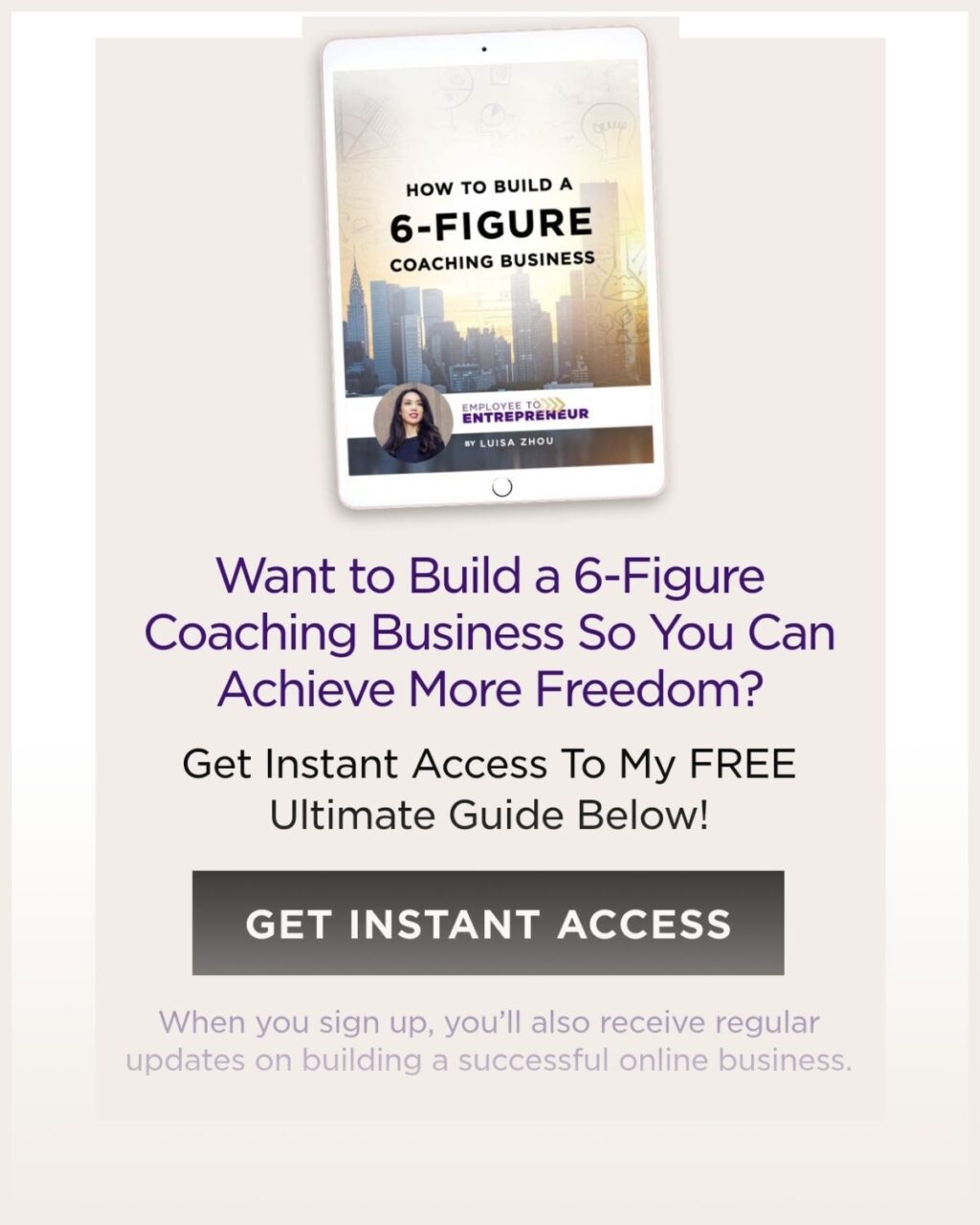
Once you have a lead magnet (which you can easily create using a tool like Canva), you need to create opt-in forms to get people to sign up for your offer.
You can use a tool like PopupAlly or OptinMonster to create your own opt-in forms. Place these opt-in forms in your blog posts:
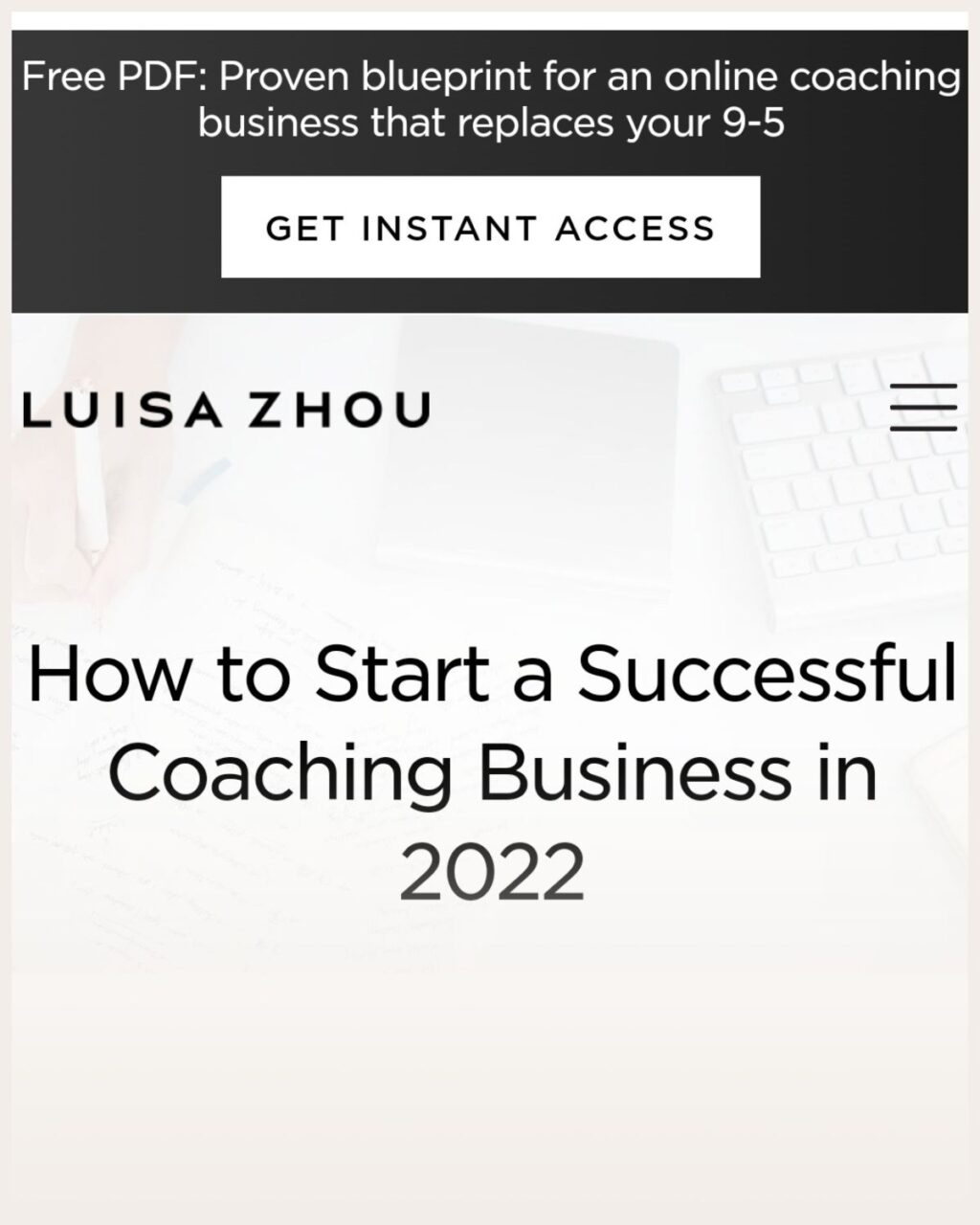
You also need an email marketing platform to build your list. You can use Mailchimp or ActiveCampaign to build your email list and send out emails.
And that’s it! That’s how you get people to sign up for your email list so that you can take them through your sales funnel.
How to create a system that works
These are the different parts that help you build your SEO. That said, SEO is a process and to build a traffic-driving system that attracts the right people and converts them, you need a proven strategy.
Together with my SEO manager, I created such a system that teaches you how to build a sustainable and highly profitable business with the help of SEO.
The 4-Step Automatic Attraction System
for attracting more clients daily... without paid ads, social media, or "hustle"!
If you want to learn more about it, get my guide “Automatic Attraction System” now!
Over to you!
There you have it! Now you know how to use SEO for coaches.
SEO can help you build a business that’s truly profitable and sustainable – one that works even if you don’t.
So that you don’t have to hustle on social media or rely on paid ads.
Want to learn more about getting clients to find you?
Then, download my free 4-step system.
